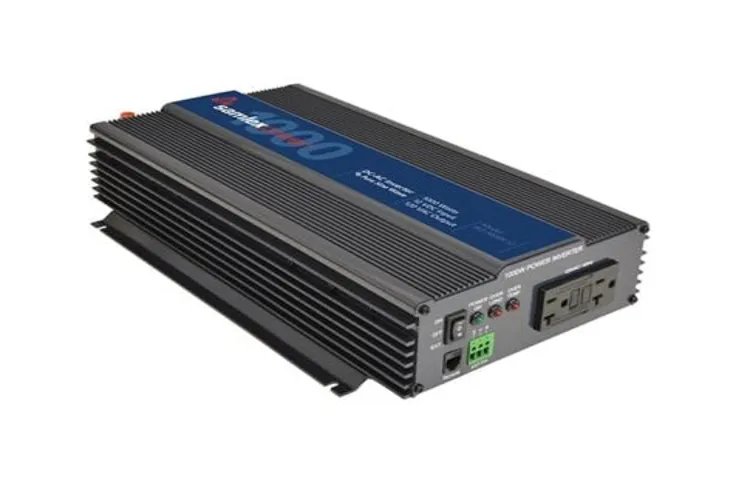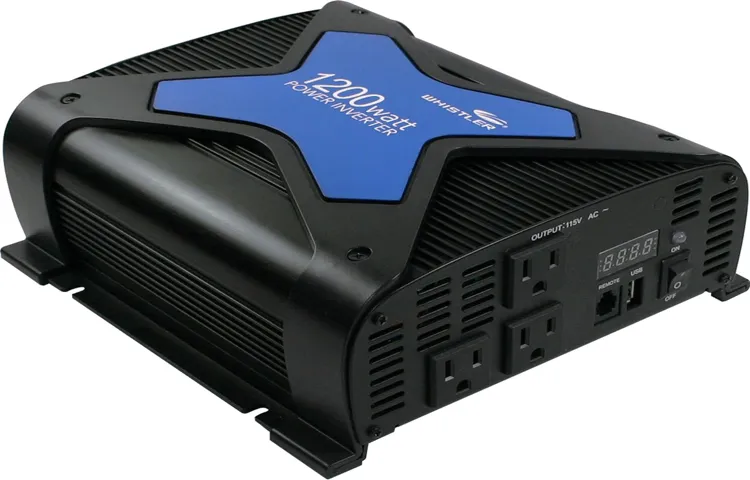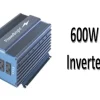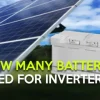Are you tired of being limited by the availability of electrical outlets when you’re on the go? Do you ever wish you could use your favorite electronic devices even when you’re off the grid? Power inverters might be the solution you’ve been looking for. Whether you’re a camper, a road tripper, or someone who simply wants to have reliable power wherever you are, understanding power inverters is crucial. When it comes to power inverters, think of them as the bridge between your electronic devices and the electricity source.
They transform the direct current (DC) from your battery or solar panel into alternating current (AC) that your devices can use. In simpler terms, they convert the voltage from one form to another to power your devices. Just like adapters that allow you to plug your laptop into different types of electrical outlets around the world, power inverters allow you to power your devices using alternative sources such as car batteries or solar panels.
They provide you with the flexibility to charge your phone, run a small appliance, or even power a refrigerator while being off the grid. Power inverters come in various sizes and power capacities. The size you choose will depend on your power needs.
For example, if you only need to charge your phone or run a small electronic device, a smaller power inverter will suffice. On the other hand, if you want to power larger appliances or multiple devices simultaneously, you will need a larger and more powerful inverter. Understanding power inverters is essential to ensure you choose the right one for your needs.
With the right power inverter, you can power your favorite devices wherever you go, allowing you to stay connected and never miss out on the conveniences of modern technology.
Table of Contents
What is a Power Inverter?
If you’re wondering how many amps a 1200 watt power inverter can produce, the answer depends on the voltage of the power source and the efficiency of the inverter itself. A power inverter converts DC (direct current) power from a battery or solar panel into AC (alternating current) power that can be used to run household appliances and devices. To determine the amperage of a 1200 watt power inverter, you need to divide the wattage by the voltage.
For example, if you are using a 12-volt power source, the amperage would be calculated as follows: 1200 watts / 12 volts = 100 amps. However, it’s important to note that this is the theoretical maximum amperage, and in practice, the actual amperage may be lower due to inefficiencies and power losses in the inverter. It’s always a good idea to check the specifications of the specific power inverter you are using to determine its true amperage output.
Explanation of power inverters and their function
power inverter, function, explanation

Understanding Watts and Amps
If you’re wondering how many amps a 1200-watt power inverter can handle, it’s important to understand the relationship between watts and amps. Watts measure power, while amps measure current. To calculate amps, you need to divide the wattage by the voltage.
In this case, let’s assume the inverter operates on a standard voltage of 120 volts. By dividing 1200 watts by 120 volts, we find that a 1200-watt power inverter can handle approximately 10 amps of current. It’s essential to consider the ampacity (maximum amount of current an electrical device can safely handle) when choosing an inverter or using it with electrical appliances.
Remember, this calculation assumes the voltage remains constant, and it’s always a good idea to check the specifications provided by the manufacturer to ensure compatibility and safety. So, if you’re planning to use a 1200-watt power inverter, make sure your electrical devices or appliances don’t exceed 10 amps.
Explanation of watts and amps and how they relate
Understanding Watts and Amps: Explained Have you ever looked at the back of your electronic devices and seen abbreviations like “W” for watts and “A” for amps? You may have wondered what these mean and how they relate to each other. Well, today we’re going to unravel the mystery and shed some light on the subject! Let’s start with amps. Amps, short for amperes, measure the flow of electric current in a circuit.
Think of it like the volume of water flowing through a pipe. The higher the amps, the more current is flowing through the circuit. This is important because different devices consume different amounts of current.
For example, a smartphone charger may only need 1 amp of current, while a hairdryer might require 10 amps. Now let’s talk about watts. Watts measure the power consumed by a device or the rate at which energy is converted or used.
To continue with our water analogy, watts would be like the pressure at which water is flowing through the pipe. The higher the watts, the more power is being used. So, if you have a device with a higher wattage, it typically means it uses more energy.
Now, how do watts and amps relate? Well, here’s where it gets interesting. Watts can be calculated by multiplying the amps by the voltage of the circuit. Voltage, measured in volts, is like the force that pushes the electric current through the circuit.
So, the formula is watts = amps x volts. This means that if you have a device that requires a higher current (amps) and a higher voltage, it will consume more power (watts). Let’s break it down with an example.
Calculating Amps from Watts
If you’re wondering how many amps a 1200-watt power inverter can handle, you’ve come to the right place. It’s important to understand the relationship between watts and amps in order to determine the capacity of a power inverter. Watts represents the amount of power consumed or generated by a device, while amps measures the current flowing through the device.
To calculate the amps, you can use the formula: Amps = Watts / Volts. In this case, assuming a standard 120-volt AC power source, a 1200-watt power inverter would draw approximately 10 amps. It’s worth noting that power inverters usually have a maximum continuous power rating, so it’s important to select an inverter that can handle the wattage of the devices you plan to use with it.
Additionally, it’s always a good idea to consult the manufacturer’s specifications for the specific power inverter model you are considering.
Step-by-step guide on how to calculate the amps from watts
Calculating amps from watts can be a useful skill to have, especially if you are working with electrical appliances or installations. Understanding the relationship between watts and amps can help you determine the electrical requirements of a device and ensure that you are using the correct circuit and breaker sizes. To calculate amps from watts, you will need to know the wattage of the device and the voltage at which it operates.
To begin, you need to divide the wattage by the voltage to get the amperage. For example, let’s say you have a device with a power rating of 1000 watts and it operates at 120 volts. The formula would be Amps = Watts / Volts.
So in this case, it would be 1000 watts / 120 volts = 33 amps. It’s important to note that this calculation assumes a direct current (DC) circuit.
If you are working with an alternating current (AC) circuit, the calculation can be slightly more complex due to factors like power factor and efficiency. In an AC circuit, the power factor is the ratio of real power to apparent power, and it can affect the relationship between watts and amps. However, for most residential and commercial applications, the power factor is close to 1, so the simple formula can still give you a good estimate.
By knowing how to calculate amps from watts, you can ensure that you are using the correct electrical load for your devices and avoid overloading circuits. It’s always a good idea to check the specifications and requirements of your devices before making any electrical connections. In some cases, you may need to use a higher amperage circuit or upgrade your electrical system to accommodate larger loads.
Safety should always be a priority when working with electricity, so if you are unsure or uncomfortable with any electrical calculations or installations, it’s best to consult a licensed electrician.
The Formula
If you’re wondering how many amps a 1200 watt power inverter can handle, the answer lies in a simple formula. To determine the amperage, you need to divide the wattage by the voltage. In this case, since most power inverters operate at 12 volts, you divide 1200 watts by 12 volts.
Doing the math, you’ll find that a 1200 watt power inverter can handle up to 100 amps of current. It’s important to note that this calculation is based on the maximum wattage of the inverter. If you’re using devices that consume less power, the amperage drawn will be lower.
So, whether you’re looking to power a small appliance or charge your electronics on the go, understanding the amperage of your power inverter is essential for making sure you have enough power to meet your needs.
The formula to convert watts to amps
Formula to convert watts to amps. Converting watts to amps may seem a bit confusing at first, but don’t worry, it’s actually quite simple. To understand the formula, let’s first clarify what watts and amps are.
Watts measure the amount of power an electrical device uses, while amps measure the flow rate of electric current. The formula to convert watts to amps is straightforward: amps = watts / voltage. Essentially, you divide the wattage by the voltage to determine the amperage.
Let’s say you have a device with a power rating of 1000 watts and it operates on a voltage of 120 volts. To determine how many amps it requires, you would divide 1000 watts by 120 volts, giving you an answer of approximately 33 amps.
It’s important to note that this formula assumes a constant voltage, as most electrical systems have. If you’re working with a variable voltage system, such as in some industrial settings, you’ll need to factor in the changing voltage to get an accurate amperage measurement. Remember, this formula is a basic guideline and may not account for other factors such as power factor or efficiency.
It’s always a good idea to consult an electrician or refer to the device’s specification sheet for accurate and specific information. In conclusion, converting watts to amps is a simple equation that involves dividing the wattage by the voltage. This formula allows you to determine the amperage required by an electrical device.
By understanding this formula, you can calculate the electrical requirements of various devices and ensure the safety and efficiency of your electrical system.
Calculating Amps for a 1200 Watt Power Inverter
If you’re wondering how many amps are needed for a 1200 watt power inverter, you’re in the right place. When it comes to power inverters, understanding the relationship between watts and amps is crucial. To calculate the amps, you can use a simple formula: Amps = Watts/Volts.
In this case, let’s assume we are using a standard 120-volt power source. So if you have a 1200 watt power inverter, you divide that by 120 volts, and you get 10 amps. This means that a 1200 watt power inverter will draw 10 amps of current from your power source.
It’s important to note that this calculation assumes 100% efficiency, which is not always the case in reality. Nevertheless, it gives you a good estimate of how much power your inverter will draw. So, whether you’re looking to power your devices during a camping trip or need a reliable backup power source at home, knowing the amps required for your power inverter is crucial in determining if it can handle your needs.
Using the formula to calculate the amps for a 1200 watt power inverter
power inverter, amps, calculate, 1200 watts Have you ever wondered how to calculate the amps needed for a 1200 watt power inverter? Well, look no further because I’m here to break it down for you. The formula to calculate the amps for a power inverter is relatively simple. All you need to do is divide the watts by the voltage.
In this case, the voltage is 120 volts, which is the standard residential voltage in the United States. So, if we divide 1200 watts by 120 volts, we get 10 amps. This means that a 1200 watt power inverter will draw approximately 10 amps of current when connected to a 120-volt power source.
Keep in mind that this calculation assumes ideal conditions and doesn’t account for any efficiency losses or other factors that may affect the actual power consumption of the inverter. Nonetheless, this formula gives you a good estimate of the amps needed for a 1200 watt power inverter. So, the next time you’re shopping for a power inverter or trying to determine the electrical requirements of your devices, you can use this formula to calculate the amps needed for your specific power inverter.
Conclusion
Well, my friends, determining how many amps a 1200 watt power inverter can handle is quite the electrifying puzzle to solve. It’s like trying to calculate the strength of a secret agent’s handshake or the number of hot dogs Joey Chestnut can devour in one minute. But fear not, for I am here to shed some light on this electrifying conundrum! So, let’s break it down.
First off, we need to understand that watts are a unit of power, while amps measure electrical current. They’re like two partners in crime, working together to give us the full picture of our power inverter’s capabilities. Now, here’s the clever part.
To determine how many amps a 1200 watt power inverter can handle, we need to dive into the world of mathematical sorcery. Remember that oh-so-famous equation: Power (in watts) = Current (in amps) x Voltage (in volts)? Well, it’s time to unleash its power. Assuming our power inverter operates at a standard voltage of 120 volts (which is quite shocking in itself), we can rearrange the equation to solve for current.
Divide the power (in watts) by the voltage (in volts), and voila! You’ve got your amperage! So, plugging in the numbers, we find that 1200 watts divided by 120 volts gives us a magical current of 10 amps. That’s right, my friends, our 1200 watt power inverter can handle a current of 10 amps with the grace and finesse of a tightrope-walking acrobat. But wait, there’s more! Let’s not forget about efficiency.
Power inverters are known for their ability to convert DC power to AC power, but they’re not perfect magicians. Some power is lost in the conversion process, like a disappearing rabbit in a hat. So, keep in mind that the actual amperage may be slightly lower due to this mystical phenomenon.
In conclusion, ladies and gentlemen, a 1200 watt power inverter can handle a current of approximately 10 amps, making it a reliable companion for your electrifying adventures. Just remember to always stay safe and never underestimate the power of a cleverly calculated conclusion!”
Summarize the information and provide any additional insights
Calculating Amps for a 1200 Watt Power Inverter can be quite helpful when it comes to understanding the power requirements for your electrical devices. To determine the amps needed for a 1200 watt power inverter, you can use a simple formula: Amps = Watts/Volts. In this case, we know that the power inverter has a 1200 watt rating.
But how do we figure out the voltage? Most power inverters operate on 12 volts, so we’ll use that as our standard in this example. Using the formula, we can calculate the amps needed for our 1200 watt power inverter: Amps = 1200 Watts / 12 Volts. This gives us 100 Amps.
Therefore, a 1200 watt power inverter would require approximately 100 amps to operate at full capacity. It’s important to note that this calculation is based on the maximum power output of the inverter. In reality, the actual power draw may be less, depending on the specific devices connected to it.
It’s always a good idea to check the power requirements of your devices and add them up to ensure you don’t exceed the capacity of your inverter. Additionally, it’s worth considering the surge or peak power rating of the inverter. Some devices, such as motors or appliances with compressors, require a higher current during start-up.
In these cases, you may need to use an inverter with a higher surge power rating to meet the initial power demand. In summary, calculating amps for a 1200 watt power inverter can help you determine the power requirements for your electrical devices. By using the formula Amps = Watts/Volts, you can estimate the amps needed to operate your inverter at full capacity.
However, it’s important to consider the actual power draw of your devices and any surge power requirements to ensure you choose the right inverter for your needs.
FAQs
What is a power inverter?
A power inverter is an electronic device that converts DC (direct current) power from a battery or solar panel into AC (alternating current) power, which is used to run household appliances and other electrical devices.
How does a power inverter work?
A power inverter works by using electronic circuitry to convert the DC power from a battery or solar panel into AC power that can be used to operate various devices. It typically consists of a transformer, rectifier, and switching circuitry.
What is the difference between a modified sine wave inverter and a pure sine wave inverter?
A modified sine wave inverter produces an output waveform that is a rough approximation of a true sine wave, while a pure sine wave inverter produces a smooth and clean sine wave. Pure sine wave inverters are generally considered to be of higher quality and are recommended for sensitive electronic equipment.
What is the maximum wattage I can connect to a 1200 watt power inverter?
The maximum wattage you can connect to a 1200 watt power inverter is 1200 watts. It is important to ensure that the total wattage of the devices you are connecting does not exceed the maximum capacity of the inverter.
Can a 1200 watt power inverter be used to power a refrigerator?
It depends on the power requirements of the refrigerator. You will need to check the wattage rating of the refrigerator and ensure that it is within the capacity of the 1200 watt power inverter. If the refrigerator has a high starting wattage, you may need a larger capacity inverter.
Can I use a 1200 watt power inverter to charge my laptop and phone?
Yes, a 1200 watt power inverter can be used to charge your laptop and phone, as long as the total power consumption of the devices does not exceed the capacity of the inverter. Most laptops and phones have relatively low power requirements and can be easily powered by a 1200 watt inverter.
Can a 1200 watt power inverter be used in a car?
Yes, a 1200 watt power inverter can be used in a car, as long as the car’s electrical system is capable of supplying enough power to the inverter. It is important to check the car’s electrical system specifications and ensure that it can handle the power requirements of the inverter.



